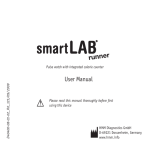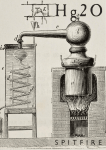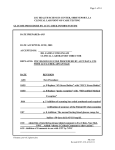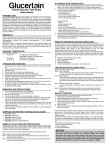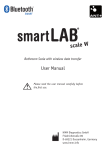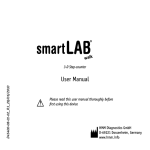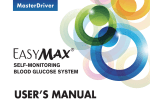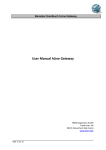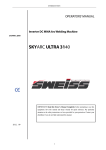Download User Manual
Transcript
ENGLISH Self-Monitoring Blood Glucose Meter User Manual Please read this manual thoroughly before first using this device HMM Diagnostics GmbH Friedrichstraße 89, D-69221 Dossenheim, Germany www.hmm.info 31 32 Contents 35 Measuring principle Intended use Important information Note on smartLAB®nG „NO CODE“-test strips 36 36 37 39 II. Your smartLAB®mini nG 40 Display & functions Specifications The smartLAB®nG test strips Explanation of symbols Set Contents 40 40 41 42 42 III. Setup & Operating procedures 43 Installing batteries Function check Notes on using smartLAB®nG blood glucose test strips Running a blood glucose test Alternate Site Testing (AST) with the transparent cap Reading stored test results from memory Understanding your test results 43 44 45 46 48 49 49 IV. Miscellaneous 52 Maintenance Troubleshooting Limitations of the measurement procedure Regularity and Safety Notice Warranty 52 53 56 59 59 33 ENGLISH I. Introduction 34 I. Introduction Please read this manual thoroughly before you begin testing. It provides you and your diabetes care team with important information and step-by-step direction to use meter correctly. Although your smartLAB®mini nG system is easy to use, you should consult your healthcare professional (this may be your doctor, diabetes nurse educator or pharmacist) for instructions on how to use the system. The only way to obtain accurate results from any system is to make sure you correctly use it. If you have any concerns, please call your authorized distributor in your country during business hours. 35 ENGLISH Thank you for using the smartLAB®mini nG Self-Monitoring Blood Glucose System (SMBG). This system was designed to be dependable, easy-to-use, compact, lightweight and portable to help you monitor your blood glucose on a regular basis. Measuring principle The smartLAB®mini nG Self-Monitoring Blood Glucose System is designed to allow rapid measurement of blood glucose by using an electrochemical biosensor technology. This system employs a disposable dry reagent strip technology, based on the FAD-binding glucose dehydrogenase. Each test strip features an electrode containing FAD-binding glucose dehydrogenase. A capillary blood sample is applied to the collecting area of the strip, and is automatically drawn into the reaction zone, where the FAD-binding glucose dehydrogenase catalyzes the glucose dehydrogenation. It will produce gluconolactone. During the reaction, a mediator transfers electrons to the electrode surface and generates a current. The amount of the current is proportional to the amount of glucose present in the blood sample. After 5 seconds, the smartLAB®mini nG will show glucose concentration on the screen. Intended use The smartLAB®mini nG is intended for the quantitative measurement of glucose in venous whole blood or fresh capillary whole blood from fingertips, palm and forearm. Testing is done outside the body (In Vitro diagnostic use). It is indicated for self-testing (over the counter [OTC]) by persons with diabetes, or in clinical settings by healthcare professionals, as an aid to monitor the effectiveness of diabetes control. The meter should be used only with smartLAB®nG blood glucose test strips. 36 Important information • The smartLAB®mini nG blood glucose meter can only be used with smartLAB®nG Blood Glucose Test Strips. Other test strips will give inaccurate results. • Severe impact may cause the meter to malfunction. Do not disassemble the meter as it may damage components inside and cause an incorrect reading. The warranty will be void if the meter has been disassembled. • Testing is not valid for neonatal blood specimens. • Incorrect results may occur when performing the test. If you believe you are not feeling well, please contact your healthcare professional immediately. • Always keep the meter clean and store it in a safe place. Protect from direct sunlight to ensure a longer lifespan. • The strip slot should be kept free from dirt, dust, blood stains, and water stains. • Do not store the meter and test strips in a car, a bathroom or 37 ENGLISH • The smartLAB®mini nG blood glucose meter is designed and approved for testing venous whole blood or fresh capillary whole blood samples from your fingertips, palm and forearm. The meter is for in vitro diagnostic use ONLY (for testing outside the body). It should not be used to diagnose diabetes. a refrigerator. And the meter, strips and lancing device should be kept away from children or pets. • Remove batteries if the meter will not be used for one month or more. • Store the kits in a dry place with temperature range is 2 to 30°C (35.6 to 86 °F). Keep away from direct sunlight and heat. • Store your test strips in their original vial only. Do not transfer them to a new vial or any other container. • Indicate the date you open the vial. Discard all unused strips immediately after 90 days from open date. The strips are for single use only. • You should not test critically ill patients with home-use blood glucose meters. • Warning for potential biohazard: Healthcare professionals using this system on multiple patients should be aware that all products or objects that come in contact with human blood, even after cleaning, should be handled as if capable of transmitting a viral disease. • Please dispose device according to the local rule of the disposition of electronic device /accessory waste. • If the equipment is used in a manner not specified by the manufacturer, the protection provided by the equipment may be 38 impaired. ENGLISH Do not touch the test strip with wet hands Do not use expired test strips (see expiration date on the strip vial) Do not bend, cut or twist the strip Consult with your healthcare professional before testing on your palm or forearm. Altitude up to 3,048 meters above sea level has no effect on readings. Health-Related Information • If you are experiencing dehydration, frequent urination, low blood pressure, shock or hyperosmolar hyperglycemic nonketotic coma (HHNKC), you may get a test result that is lower than what your blood glucose really is. If you think you are dehydrated, call your healthcare professional right away. • If you have followed the steps in the user’s manual, but still have symptoms that do not seem to match your test results, or if you have questions, please contact your healthcare professional. • Please read your test strip instructions carefully for additional health-related information Note on smartLAB®nG „NO CODE“-test strips The smartLAB®nG blood glucose test strips compatible with smartLAB®nG glucose systems need not to be coded, any more. 39 II. Your smartLAB®mini nG Display & functions Test result Error code Me a s u r i ng unit Code number Apply blood to the test strip Thermometer Battery power Specifications 1. Type: smartLAB®mini nG 2. Measuring range: 20~630 mg/dL (1.1~35.0 mmol/L) 3. Measuring duration: 5 seconds 4. Memory: 20 values 5. Operating temperature: 10°C~40°C (50°F~104°F) 6. Relative humidity: RH ≤90% 7. Storage Temperature: -20°C ~50°C (-4°F~122°F) 8. Blood sample: ≥ 0,6 µL capillary or venous whole blood 9. Calibration: Plasma equivalent 10. Hematocrit (Hct): 30-55% 11. Battery type: 2 CR 3V Lithium bat- teries 12. Battery life: over 3000 measurements 13. Display-size: 30 x 30 mm 14. Meter dimensions: 80 x 50 x 5 mm 15. Weight: 20g (without batteries) 16. Transportation temperature: -20°C ~50°C (-4°F~122°F) 17. Transportation humidity: RH ≤90% 40 The smartLAB®nG test strips ENGLISH Electrode Insert direction Grip zone Reaction zone Aperture Application zone Vial opening date (please note) Expiration date Note: You can find the test strip expiration date on the vial label next to the symbol. 41 Explanation of symbols Caution This product meets the requirements of Directive 98/79/CE for in vitro diagnostic medical devices. Lot number Expiration date For in vitro diagnostic use only + Use Lithium battery CR 2032 3V Single use only Storage temperature Manufacturer Before use, read manual first Catalogue number Serial number Opening date of test strip vial Set contents 1 smartLAB®mini nG blood glucose meter 1 User manual 1 Wallet for safe transportation 2 CR 2032 3V batteries 1 smartLAB® lancing device 1 smartLAB® Check Strip 1 smartLAB® Quick Start instruction 10 smartLAB® lancets 10 smartLAB®nG blood glucose test strips 42 III. Setup & Operating procedures The meter uses two CR 2032 3V Lithium batteries. Batteries will normally last for aprox. 3000 tests. Other types of CR 3V lithium batteries are also acceptLow battery symbol able, yet the capacity of test times may differ. Install the batteries when you first use the meter by remving the battery protection or replace with new batteries when the “LP” message and the low battery symbol appear on the LCD display. Open the battery lid on the back side of the smartLAB®mini nG meter and insert batteries with plus sign to top. First insert the battery on the right side and then press the left side down until it clicks. Close the battery lid. The display will light up for one second. Afterwards the device will turn off automatically. Note: 1. Remove the batteries when you will not be using the meter for one month or longer. 2. Values won’t be deleted when the batteries are replaced. Meter, batteries, lancets, test strips etc. must be disposed of according to local regulations at the end of their usage. 43 ENGLISH Installing batteries Function check You can carry out a function check with the Check Strip which is included in your meter set. You do not have to do the function check before every measurement. It helps you to control if your smartLAB®nG meter works properly, from time to time, though. 1. Insert check strip into the meter: Make sure your check strip is inserted with writing to top. The meter will turn on automatically and the display will show „CHK“. 2. Check message in LCD display: The function check will take approx. 3 seconds. The check can produce the following messages on the display: • „OK” - your meter works properly • „FAL“- change batteries and check again. If the message still appears, please refer to your local supplier. 3. Remove check strip: The meter will turn off automatically after removing the test strip. Please keep the check strip in the soft case of the meter. 44 Notes on using smartLAB®nG blood glucose test strips 45 ENGLISH • Use only with smartLAB®nG Blood Glucose Meters. • Run a control solution test every time you open a new box of test strips • Keep the test strips in their original bottle. • After you take a test strip out of the bottle, tightly close the bottle immediately. This keeps the test strips dry. • Use the test strip within three minutes after taking it out of the bottle. • The strip is for single use only. Do not reuse it. • Record the date you open the test strip bottle. Be sure to check the expiration date on the test strip bottle. The test strip is good for 6 months from the date the bottle is opened or until the expiration date on the bottle, whichever comes first. • Store the test strip bottle and your meter in a cool dry place. • Store the test strips between 2°C ~30°C (36°F - 86°F). Do not freeze. • Do not apply blood or control solution to the test strip before you insert it into the meter. • Do not touch the test strip with wet hands. Do not bend, cut, or twist the test strips. Running a blood glucose test 1. Preparations Before running a blood glucose test, make yourself acquaint with the test strips and the lancing device. Keep all required materials ready for use: your smartLAB®mini nG meter, the smartLAB®nG test strips and the smartLAB® lancing device including lancets. Wash your hands thoroughly with warm water before colleting the blood sample. Rinse your hands thoroughly. 2. Switch on the meter Take a strip out of the vial and immediately close it. Insert the strip into the meter in the direction of the arrow on the strip. The meter turns on automatically. 3. Collecting a blood sample When the blood drop flashes on the display, gently massage the part of your finger tip which you obtain a drop of blood from using the lancing device. Place the lancing device against the pad of your finger. Press the trigger button to activate the lancing device. 46 5. Storing memories The displayed result is automatically stored in the memory of the meter. If more than 20 results are reached, the oldest one is deleted. 6. Discarding used test strips and lancets Write down the measured result in your personal diabetic log book and take the test strip off the strip slot. The meter turns off. If you don’t take off the test strip, the meter will turn off automatically after 5 minutes. In order to discard lancets from the smartLAB® lancing device, remove the end cap and carefully pull the used lancet out of the holder. Dispose of the lancet of according to local regulations. 47 ENGLISH 4. Blood glucose measurement Hold the application zone of the test strip vertically onto the blood sample. The blood is automatically sucked in the reaction zone of the test strip. Be sure to get enough blood on the strip’s reaction zone, otherwise, an inaccurate reading may result. The signal tone indicates that enough blood entered the reaction zone. The meter will now start with the measurement which will last 5 seconds. The LCD display shows the remaining time of measurement in seconds. Afterwards the note „OK“ indicates a correct measurement. The measurement is finished with another signal beep and the measured value is shown on the display. Alternate Site Testing (AST) with the transparent cap You can also gain the blood sample from other parts of the body than the finger tip. If you want to use Alternate Site Testing, please use the transparent cap for your lancing device. Carry out the following steps: • Gently massage the desired punctuation site on your arm or hand for a few seconds. This will improve the blood circulation. Alternate Blood Collection Sites • Push the lancing device with the transparent cap against the desired blood collection site and push the trigger button to gain a sample. • Exercise a constant pressure until you see through the transparent cap, that enough blood is gained. After that you can carry out the blood glucose test, as usual. 48 Reading stored test results from memory Understanding your test results The smartLAB®nG blood glucose test strips are plasma referenced and calibrated for easier comparison to lab results. The unit of blood glucose test results displayed on the screen is either mg/ dL or mmol/L, depending on which unit of measurement you have selected. The mmol/L results will always include a decimal point; mg/dL results do not include a decimal point. Expected results for non-diabetic adults: The normal fasting glucose range is 70 to 100 mg/dL (3.9 to 6.1 mmol/L). Two hours after meals, normal glucose values should be less than 120 mg/dL (6.7 mmol/L). Expected results for diabetic adults: The normal fasting blood glucose range for an adult with diabetes is 70-130 mg/dL (3.9~7.2 mmol/L)*. Two hours after meals, the blood glucose range for an adult with diabetes is less than 180 mg/dL (10.0 mmol/L). For further queries about diabetes: please consult your healthcare professional for the blood glucose range appropriate for you. Unusual test results: If your blood glucose result doesn‘t match the way you feel, follow 49 ENGLISH You can read the last 20 test results on the internal memory of your smartLAB®mini nG meter by inserting the check strip. The results will be shown chronologically on the display. these steps, and then repeat the test: 1. Check if the strips are within the expiration date. 2. Be sure that the drop of blood completely filled the reaction zone of the test strip 3. Do a function control test with the smartLAB® check strip 4. Repeat the Measurement: If the values of the repeated measurements are however questionable and do not match the way you feel, please contact your health care professional before you change your medication. Note: 1. Extremely high humidity may affect the test results. A relative humidity greater than 90% may cause inaccurate results. 2. A red blood cell count (Hematocrit) below 30% may cause higher results. Hematocrit above 55% may cause lower results. 3. Some studies have shown that electromagnetic fields may affect results. Do not test near an operating microwave oven. Symptoms of high or low blood glucose: Being aware of the symptoms of high or low blood glucose can help you understand your test results and decide what to do if they seem unusual. A high blood glucose would be greater than 240 mg/dL (13.33 mmol/L). A low blood glucose would be below 60 mg/dL (3.33 mmol/L). Here are the most common symptoms: High blood glucose (hyperglycemia): fatigue, increased appetite or thirst, frequent urination, blurred vision, headache, general aching, or vomiting. 50 Comparing your meter‘s result to a lab result: A common question is how the blood glucose results on your meter compare to the lab results. Your blood glucose can change quickly, especially after eating, taking medication, or exercising. If you test yourself in the morning, then go to the doctor’s office for a blood glucose test. The results will probably not match, even if you are fasting. This is typically not a problem with your meter, it just means that time has elapsed and your blood glucose has changed. If you want to compare your meter result to the lab result, you must be fasting. Bring your meter to the doctor’s office, and test yourself by fingertips within five minutes of having blood drawn from your arm by a healthcare professional. Keep in mind that the lab could use different technology than smartLAB®mini nG Blood Glucose System, and that blood glucose meters for self testing generally read somewhat lower or higher than the lab result. For accuracy and precision data and for important information on limitations, see the instructions that come with your test strips. 51 ENGLISH Low blood glucose (hypoglycemia): sweating, trembling, blurred vision, rapid heartbeat, tingling, or numbness around mouth or fingertips. If you are experiencing any of these symptoms, test your blood glucose. If your blood glucose result is displayed greater than 240 mg/ dL (13.33 mmol/L) or below 60 mg/dL (3.33 mmol/L) and you have symptoms of low or high blood glucose, contact your doctor immediately. If your blood glucose result does not match how you feel, follow the steps under „Unusual Test Results.“ IV. Miscellaneous Maintenance Your smartLAB®mini nG blood glucose meter does not require any special cleaning. Just keep the meter free of dirt, dust, blood- and water stains. Following these guidelines carefully will help you getting the best performance possible: Gently wipe the meter‘s surface with a soft cloth. Do not get any moisture in the test strip slot. Please do not spray any cleaning solution directly onto the meter. Do not pour liquid into the system or put the meter under water or liquid To clean the lancing device, use a mild dishwashing liquid and a soft cloth. DO NOT place the entire device under water. Please make sure that no liquids enter the meter‘s apertures. 52 Troubleshooting Battery empty Display: „LP“ & „Battery symbol “ Solution: Replace with new batteries. Not enough blood in test strip Display: „Err“ and test strip with hand If not enough blood is in the test strip, this error will show. Solution: Use a new test strip and restart the measurement procedure. System error Display: „001 Error “ Solution: Replace batteries first. If the error still occurs, please contact your local supplier. 53 ENGLISH Note: If you are not sure how to react on error codes, please contact your local supplier. Memory error Display: „005 Error“ Solution: Replace batteries first. If “Err”still occurs, please contact your local supplier. Test strip already used or wet Display: „Err“ & „Test strip symbol“ Solution: Use a new test strip. Temperature too high Display: „Ht“ & „Thermometer symbol“ The operating temperature is too high (above the required temperature range from 10°C 40°C (50°F - 104°F)). The error is a warning that a continuation under these conditions might lead to wrong blood glucose readings. Solution: Take the meter to a location with appropriate working temperature and wait for the next measurement until the error does not occur again. 54 Test result is higher than 630 mg/dL (35.0 mmol/L) Display: „HI“ Solution: Test again. If the result is still too high, please contact your doctor immediately. Test result is under 20 mg/dL (1.1 mmol/L) Display: „LO“ Solution: Test again. If the result is still too low, please contact your doctor immediately. 55 ENGLISH Temperature too low Display: „Lt“ & „Thermometer symbol“ The operating temperature is too low (below the required temperature range from 10°C 40°C (50°F - 104°F)). The error is a warning that a continuation under these conditions might lead to wrong blood glucose readings. Solution: Take the meter to a location with appropriate working temperature and wait for the next measurement until the error does not occur again. Limitations of the measurement procedure 1. DO NOT use serum or plasma sample. 2. DO NOT use neonate blood sample. 3. DO NOT use anticoagulant NaF or potassium oxalate for venous sample preparation. 4. Extreme humidity may affect the results. A relative humidity greater than 90% may cause incorrect results. 5. The system is designed to be used at temperatures between 10°C and 40°C (50°F and 104°F). Outside this range, the system may yield erroneous results. 6. DO NOT reuse the test strips. The test strips are intended for single use only. 7. DO NOT use iodoacetic acid, fluoride or sodium fluoride/oxalate as a preservative for blood specimens. 8. Hematocrit: Test strip results are not significantly affected by hematocrits in range of 30% to 55%. Hematocrit levels less than 30% may cause incorrect high readings and hematocrit levels greater than 55% may cause incorrect low readings. If you do not know your hematocrit level, consult your healthcare professional. 9. Critically ill patients should not be tested with smartLAB®nG Blood Glucose Systems. 10. DO NOT use during xylose absorption testing. Xylose in the blood will interfere Self-Monitoring Blood Glucose System. 56 11. Patients undergoing oxygen therapy may have inaccurate results. 13. Test results may be false if the patient is severely dehydrated or severely hypertensive, in shock, or in hypoglycemic-hyperosmolar state (with or without ketosis). Critically ill patients should not be tested with home-use blood glucose meter. 14. Elevated cholesterol and triglyceride levels may interfere with the way light is reflected producing erroneous meter results. 15. Recent studies have shown that EMI can cause electronic medical device performance degradation and could lead to inappropriate therapy. 16. Lipemic samples: Cholesterol level up to 500 mg/dL (12.92 mmol/L) and triglycerides up to 3,000 mg/dL (33.6mmol/L) do not affect the results. Grossly lipemic patient samples have not been tested and are not recommended for testing with smartLAB®mini nG Blood Glucose System. 57 ENGLISH 12. Altitude up to 3050 meters above sea level has no effect on readings. 17. Interfering Substances depend on the concentration. The below substances up to the test concentration will not affect the test results: Concentrations of the interferance tested Bias Glucose Level 80 mg/dL (4.4 mmol/L) 250 mg/dL (13.9 mmol/L) 500 mg/dL (27.8 mmol/L) Ascorbic Acid 4 mg/dL (0.26 mmol/L) 10.89% -1.76% 4.55% Ibuprofen 50 mg/dL (2.43 mmol/L) 3.10% 2.88% 4.62% L-Dopa 1.8 mg/dL (0.09 mmol/L) 10.59% 7.91% 4.90% Sodium Salicylate 50 mg/dL (3.12 mmol/L) -2.59% 9.42% -0.84% Tetracycline 1.5 mg/dL (0.03 mmol/L) -5.32% 3.81% 3.20% Tolbutamide 100 mg/dL (3.70 mmol/L) -2.60% 12.30% 0.89% Bilirubinunconjugated 2.4 mg/dL (0.04 mmol/L) -2.52% 4.05% -0.23% Uric acid 8 mg/dL (0.48 mmol/L) 2.71% 9.55% -1.75% Xylose 4 mg/dL (0.27 mmol/L) -5.12% -1.64% -4.44% 58 Regularity and Safety Notice The WEEE (Waste Electrical and Electronic Equipment) Directive, that came into effect as European law on 13th February 2003, led to a major change in the disposal of electrical equipment. The primarily purpose of this directive is to prevent electronic waste (WEEE), while encouraging for reuse, recycling and other forms of reprocessing to reduce waste. The WEEE logo on the product and the packaging indicates that it is not allowed to dispose of the product in the ordinary household waste. It is your responsibility to deliver all the disused electrical and electronic equipment to the respective collection points. A separate collection and proper recycling of electronic waste helps dealing economically with natural resources. Furthermore, the recycling of electrical waste is a contribution to the conservation of our environment and thus the health of all people. More information concerning the disposal of electrical and electronic devices, reprocessing and the collection points you can get from the local authorities, waste disposal companies, from retailers and manufacturers of the device. Warranty HMM Diagnostics GmbH products need to fulfill high quality requirements. Because of this reason, HMM Diagnostics GmbH gives a 2-year warranty by purchasing this smartLAB® product. You can even extend the warranty from 2 to 5 years without extra pay when you register your product. Please register online under following website: www.hmm.info/en/registration. Wear parts, batteries etc. are excluded from warranty. 59 ENGLISH WEEE note Hersteller/Manufacturer: HMM Diagnostics GmbH Friedrichstr. 89 D-69221 Dossenheim, Germany mail: [email protected] www.hmm.info Weitere Informationen zu den smartLAB® Produkten / More information on our smartLAB® products: www.smartlab.org 60
































